Today, I’m visiting Powis Castle near Welshpool; I love castles, and this one is both impressive and has stunning gardens. The earliest castle on the site dates back to the 13th century, but little remains. The old red sandstone castle, perched on its rocky outcrop which we see today, dates back to late Medieval times with a lot of subsequent rebuilding, repairing and extension in the 16th century when it came into the hands of the Herberts.
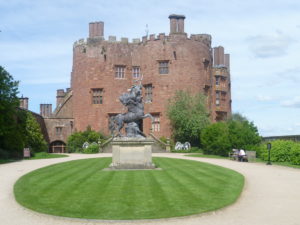
Powis Castle with the lead statue of Fame in front of it
By the 17th century, the need for fortification gradually gave way to more gracious living, and an Italian or French style garden was a must: water features, statuary, terraces, stairs leading down to new vistas and so on. The Powis Castle gardens have been described as Britain’s answer to a Tuscan Renaissance garden. It reminds me of the gardens at Tivoli, and the Villa Lante – though it’s much more precipitous.
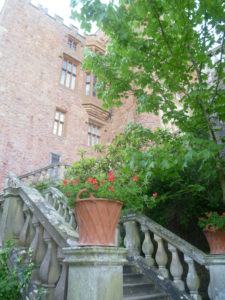
There are lots of stairs. I love the terracotta pots with geraniums.
Work began in the 1670s, and the rock on which the castle stands was hewn into a series of spectacular garden terraces. Heaven knows how they did it; the work force alone must have been huge. The result is the best remaining example of a Baroque garden in the UK. Some of the water features may have disappeared but everything else is there.
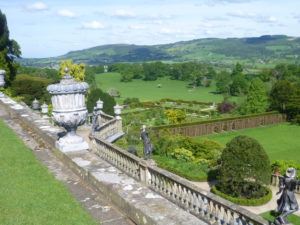
Terrace with urn and lead statues
Here we are looking down on the next terrace. Lead statues of rustic figures – a shepherdess, a piper and so on dance along the top of the balustrade. In the distance, Long Mountain marks the border with England. At the very bottom of the valley, you can just see the remains of the Dutch-style formal garden’s clipped hedging.

A close up of the piper with the urn in the background on the right
One of the joys of the castle’s terraced gardens tumbling down the cliff side, is that there’s a wonderful view whichever way you look. The statue of the piper shows the love of rustic informality typical of the period – we might almost be in Marie Antoinette’s Petit Trianon.
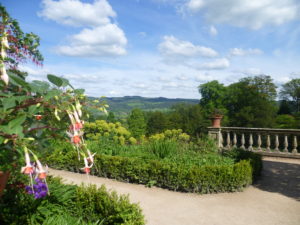
Another level another view – this time with fuchsia
We are lower down here; Long Mountain has flattened out and the formal garden in the valley has disappeared. Note the traditional box hedging round the plants.
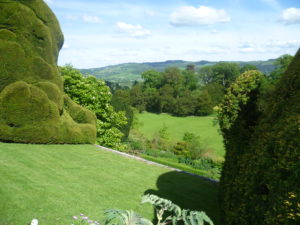
You can’t miss the cloud-like ‘tump’ on the left.
One cannot miss the huge, cloud-like clipped yews, known as tumps, along the terraces. They are over 300 years old. Originally, they were clipped into the fashionable 18th century cones and pyramids and you can just see neatly trimmed box-hedging in the background in the photo above. However, fashions change, and, by the end of the 18th century, landscape gardening came into fashion, as promoted by Capability Brown and others, where gardens merge into the landscape, which itself is carefully designed and where the trees are shaped to fit the designer’s overall conception.
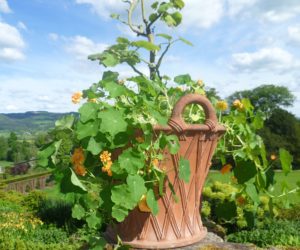
Terracotta basket-shaped pot with nasturtiums
The topiary yews were allowed to grow into tumps, and become more tree-like. The problem then arose: how on earth do you keep the yew tumps, which are over 14 metres high, trimmed? The answer is, with difficulty – and some high-tech machinery. In late summer, a gardener on a cherry-picker, trims them over ten weeks, while two other gardeners trim the yews lower down, and two more gardeners take six weeks to clip all the box hedges.
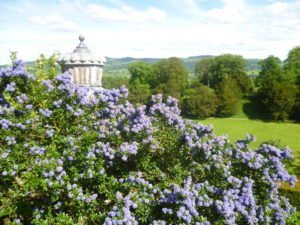
Another, lower, view
Before the advent of electric shears and a cherry-picker, it took ten men four months to do the trimming and, as old photographs show, the top of the tumps could only be reached by tying two long ladders precariously together.

At ground level, the visitor discovers what is left of a formal garden with a high yew hedge in the background, and some traditional cone-shaped topiary in front of it. The fountain is one of the few original water features to survive – it even works.

Wisteria waterfalls over a brick arcade
The 18th century was a class-conscious age and the personal privacy of the garden’s visitors was paramount; gardeners would scuttle out of sight if my lord or my lady appeared. Or, perhaps, if a lady and gentleman wished for a few moment’s privacy, the wisteria could surely grant it – (I am not a novelist for nothing.)
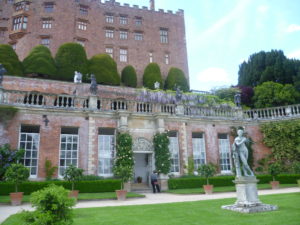
Looking up at the castle from the orangerie below
At ground floor level, not too far from the wisteria, there is an orangerie where a gentleman might converse with a lady in reasonable privacy, and it struck me that any young and nimble lady or gentleman could surely get out of sight of a tiresome chaperone in a matter of minutes! Enough of that; the writers among you will, I’m sure, discover your own adventurous possibilities for romance, murder, or skullduggery.
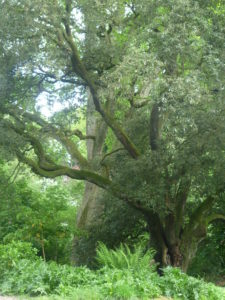
Gnarled tree in the woods
As well as the garden, there is also a very pleasant wood to wander in.
The Herberts lived at Castle Powis until 1952. George Charles Herbert (1862-1952) the 4th Earl of Powis, tragically lost both his sons in the First World War, and his wife was killed in a car accident in the 1920s. He bequeathed Powis Castle to the National Trust at his death.
If you love visiting unusual gardens, Powis Castle gardens is the place for you, and the castle itself is well worth a visit. Furthermore, as one might expect from the National Trust, there is an excellent cafe.
Elizabeth Hawksley
Please share this page...
What a super post for a wet and windy English weekend. Thank you, Elizabeth. I love your posts, and especially the views of the gardens here. Wonderfully relaxing.
Thank you, Melinda. It’s been wet and windy here, too – which is why I decided that a trip to Powis Castle gardens was in order. I’m glad you enjoyed it, and I think you’ll agree that, from a novelist’s point of view, there’s a lot you can do with a garden like that!
Your lovely photos brought back very happy memories of visiting Powys on family holidays in my early teens. The views from the terrace over the gardens and valley are stunning. I also recall that there is a connection with Clive of India? Another place for me to revisit when I get the chance!
Thank you for dropping by, Penny. There is indeed a Clive of India connection. The sister of George Herbert,the 2nd Earl, married Clive of India’s son. Their son inherited both the castle and the Clive fortune – which was just as well as the 2nd Earl had died deeply in debt, and the castle badly needed repairs and restoration.
We visited Powys Castle three years ago on a gathering to scatter the ashes of a much loved friend on the Welshpool and Llanfair Railway followed by a visit to the castle and tea there. It was a perfect day for our friend Tony – a steam railway and a stately home in glorious weather!
There is a connection to the devotional poet George Herbert, from a collateral branch of the family. Many of his poems were set to music as hymns including “ Let all the world in every corner sing, My God and King”. John and Charles Wesley used at least forty of his verses in the Methodist hymn book .
I hadn’t realized that George Herbert was connected to the Powis Herberts – how interesting. He was one of the Metaphysical Poets, along with John Donne; I studied him at University. I’ve just found a nice Herbert quote: ‘Drink not the third glass – which thou can’t not tame/ When once it is within thee.’
We visited Powis Castle three years ago while on a journey to scattered the ashes of a much loved friend on the Welshpool and Llanfair Railway. We followed the main event with a visit to the castle and a delicious tea there. It was a perfect send off for our friend Tony – a steam railway, a stately home and fine gardens and all in the beautiful surroundings of the Welsh Borders.
There is a family connection between the Earls of Powis and the devotional poet George Herbert who was from a collateral branch of the family. His work is still familiar today because so many of his verses were adapted as hymns. The Wesley brothers alone adopted around forty of his poems for the Methodist Hymn book. Perhaps the best known of these is “Let all the world in every corner sing: my God and King”
Beautiful place. And yes, a historical novelist’s dream. Envy you that visit very much.
Thank you, Elizabeth. I’d love to see it in autumn. There are woods on the valley floor that you can wander in, and the woods must look magnificent then. I wonder if they have red squirrels.
Very impressive looking fortifications and truly gorgeous gardens!
We are so fortunate that it has been so well kept.
I agree, Huon – and thank you for dropping in. I wouldn’t want to be one of the gardeners with the job of trimming the yew tumps 14 metres up, though!